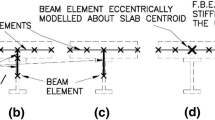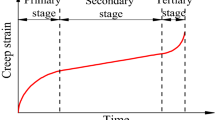Abstract
This paper describes a component-based model for simulating the behaviour of flexible end-plate connections between beams and columns in steel framed structures in fire conditions. In this method, a simple steel connection was split into a number of active components for which mechanical properties are represented by non-linear springs. The behaviour of a steel connection is then determined by assembling the individual behaviour for each active component into a spring model. The component model presented in this paper is capable of predicting the behaviour of steel connections under varied loading conditions. It is also capable of predicting the tying resistance and critical components of failure for steel connections in fire. Compared with experimental test data, a good correlation with the simplified model has been achieved and this method, combined with finite element modelling, may be used to examine the performance of simple steel connections in fire conditions.
Similar content being viewed by others
References
Al-Jabri, K.S., Burgess, I.W. and Plank, R.J. (2005). “Spring-stiffness model for flexible end-plate bare-steel joints in fire.” Journal of Constructional Steel Research, Vol. 61, pp. 1672–1691
Allam, A.M., Burgess, I.W. and Plank, R.J. (2002). “Performance-Based Simplified Model for a Steel Beam at large Deflection in Fire.” Proceedings of 4th International Conference on Performance-Based Codes and Fire Safety Design Methods, Melbourne, Australia
Ang K.M. and Morris, G.A. (1984). “Analysis of 3-Dimensional Frames with Flexible Beam-Column Connections.” Canadian Journal of Civil Engineering, Vol. 11, pp. 245–254
Aribert, J. M., Younes, I. and Lachai, A. (2002). “Low-cycle fatigue of steel connections subjected to a transverse concentrated load: experimental investigation and practical formulation.” Eurosteel 2002-3rd European Conference on Steel Structures, Coimbra, Portugal, Editor: Antonio Lamas and Luis Simões da Silva, Volumne 2, pp. 1067–1078
Block, F.M. (2002). “Numerical and Analytical Studies of Unstiffened Column Webs at Elevated Temperatures.” Internal Report, Department of Civil and Structural Engineering, University of Sheffield
Block, F.M., Burgess, I.W. and Davison, J.B. (2004). “Numerical and Analytical Studies of Joint Component Behaviour in Fire.” SIF04-Third International Workshop on Structures in Fire, Ottawa, Canada, pp. 383–395
Block, F.M., Burgess, I.W., Davison, J.B. and Plank, R.J. (2004b). “A Component approach to modelling steelwork connections in fire: behaviour of column webs in compression.” Proceedings of SCE Structures Congress 2004, Nashville, Tennessee
Block, F.M., Burgess, I.W., Davison, J.B. and Plank, R.J. (2007). “The Development of A Component-Based Connection Element for End-plate Connections in Fire.” Fire Safety Journal, Vol. 42, pp. 498–506
Block, F.M. (2006). “Development of a Component-Based Finite Element for Steel Beam-to-Column Connections at Elevated Temperatures.” PhD thesis, University of Sheffield
Burgess, I.W. (2007). “Connection Modelling in Fire.” Proc. COST C26 Workshop “Urban Habitat Constructions under Catastrophic Events.” Prague, pp. 25–34
El-Rimawi, J.A. (1989). The Behaviour of Flexural Members Under Fire Conditions, PhD Thesis, Department of Civil Engineering, University of Sheffield.
European Committee for Standardization (CEN), BS EN 1993-1-8, (2005a). Eurocode 3: design of steel structures, Part 1.8: Design of Joints, British Standards Institution, UK
European Committee for Standardization (CEN), BS EN 1993-1-2, (2005b). Eurocode 3: design of steel structures, Part 1.2:, General rules- structural fire design, British Standards Institution, UK
Girão Coelho, A.M. (2004). “Characterization of the ductility of bolted end-plate beam-to-column steel connections.” PhD thesis, Universidade de Coimbra
Girão Coelho, A.M., Simões da Silva, L. and Bijlaard, F.S.K (2004). “Ductility analysis of end-plate beam-to-column joints.” Eurosteel 2005-4th International Conference on Steel and Composite Structures, Maastricht, The Netherlands, Editor: B. Hoffmeister and O. Hechler, Volume C, pp. 123–130
Hayes, M.D. (2003). “Structural analysis of a pultruded composite beam: shear stiffness determination and strength and fatigue life predictions.” PhD thesis in Engineering Mechanics, Faculty of the Virginia Polytechnic Institute and State University.
Hu, Y., Davison, J.B., Burgess, I.W. and Plank, R.J. (2007). “Comparative Study of the Behaviour of BS 4190 and BS EN ISO 4014 Bolts in Fire.” ICSCS07: Proceedings of The 3rd International Conference on Steel and Composite Structures, Manchester, UK.
Hu, Y., Davison, J.B., Burgess, I.W. and Plank, R.J. (2008). “Experimental Study on Flexible End-plate Connections in Fire.” Eurosteel 2008: 5th European Conference on Steel and Composite Structures, Graz, Austria, in press.
Jaspart (1998). Contributions to recent advances in the field of steel joints: Column bases and further configurations for beam-to-column joints and beam splices, Professorship Thesis, Université de Liège, Belgium.
Jaspart (1999). “Semi-Rigidity in Connections of Structural Steelworks: Theory, Analysis and Design.” Lecture notes for Advanced Professional Training, Italy.
Johansson, B. and Lagerqvist, O. (1995). “Resistance of Plate Edges to Concentrated Loads.” Journal of Constructional Steel Research, Vol. 32, pp. 69–105
Kirby, B.R. (1995). “The Behavior of High-strength Grade 8.8 Bolts in Fire.” Journal of Constructional Steel Research, 33(1), pp. 3–38
Lagerqvist, O. and Johansson, B. (1996). “Resistance of I-girders to Concentrated Loads.” Journal of Constructional Steel Research, Vol. 39, No. 2, pp. 87–119
Simões da Silva L., Santiago A. and Vila Real P. (2001). “A component model for the behaviour of steel joints at elevated temperatures.” Journal of Constructional Steel Research, Vol. 57, pp. 1169–1195
Madabhusi-Raman, P. and Davalos, J.F. (1996). “Static shear correction factor for laminated rectangular beams.” Composites Part B: Engineering, Vol. 27, No. 3-4, pp. 285–293
Owens, GW. and Moore, D.B. (1992). “Steelwork Connections: The Robustness of Simple Connections”, The Structural Engineer, Vol. 70, No. 3/4, pp. 37–46
Piluso, V, Faella, C. and Rizzano, G. (2001). “Ultimate Behaviour of Bolted T-Stubs. Two: Model Validation”, Journal of Structural Engineering, ASCE, Vol. 127, No. 6, pp. 694–704.
Ramberg, W. and Osgood, W.R. (1943). “Description of Stress-Strain Curves by Three Parameters.” National Advisory Committee for Aeronautics, Technical Report 902.
Rex, C.O. and Easterling, S.W. (2003). “Behaviour and modelling of a bolt bearing on a single plate.” Journal of Structural Engineering, ASCE, Vol. 129, No. 6, pp. 792–800.
Richard, R.M. and Elsalti, M.K. (1991). “PRCONN, Moment-Rotation Curves for Partially Restrained Connections.” Users manual for program developed at The University of Arizona, Department of Civil Engineering and Engineering Mechanics, Tucson, Ariz.
Sarraj, M. (2007). “The Behaviour of Steel Fin Plate Connections in Fire.” PhD thesis, University of Sheffield
Spyrou, S. and Davison J.B. (2001). “Displacement measurement in studies of steel T-stub connections.” Journal of Constructional Steel Research, 57, pp. 647–659
Steel Construction Institute and British Constructional Steelwork Association, SCI P212 (2002). Joints in Steel Construction Simple Connections, Silwood Park, Ascot, SL5 7QN, London
Swanson, J.A. (1999). “Characterization of the strength, stiffness and ductility behaviour of T-Stub connections.” PhD dissertation, Georgia Institute of Technology, Atlanta, USA
Swanson, J.A. and Leon, R.T. (2001). “Stiffness Modelling of Bolted T-Stub Connection Components.” Journal of Structural Engineering, Vol. 127, No. 5, pp. 498–505
Spyrou, S., Davison, J.B., Burgess, I.W. and Plank, R.J. (2004). “Experimental and Analytical Investigation of the Tension Zone Component within a Steel Joint at Elevated Temperatures.” Journal of Constructional Steel Research, Vol. 60, No. 6, pp. 867–896
Spyrou, S. (2002). Development of a component based model of steel beam-to-column joints at elevated temperatures, PhD Thesis, Department of Civil and Structural Engineering, University of Sheffield.
Tschemmernegg, F., Tautschnig, A., Klein, H., Braun, Ch. and Humer, Ch. (1987). “Zur Nachgiebigkeit von Rahmenknoten-Teil 1.” Semi-rigid joints of frame structures Vol. 1 — in German, Stahlbau 56, Heft 10, S. 299–306.
Weynand, K., Jaspart, J. P. and Steenhuis, M. (1995). “The Stiffness model of revised annex J of Eurocode 3.” Proceedings of 3rd International Workshop on Connections, Trento, Italy, pp. 441–452.
Yu, H.X., Davison, J.B., Burgess, I.W. and Plank, R.J. (2007). “Experimental Investigation of the Robustness of Fin Plate Connections in Fire.” Proc. ICASS 2007, Singapore, pp. 722–727.
Yu, H.X., Burgess, I.W., Davison, J.B. and Plank, R.J. (2008). “Experimental Investigation of the Behaviour of Fin Plate Connections in Fire.” Journal of Constructional Steel Research, Article in Press.
Author information
Authors and Affiliations
Corresponding author
Rights and permissions
About this article
Cite this article
Hu, Y., Davison, B., Burgess, I. et al. Component modelling of flexible end-plate connections in fire. Int J Steel Struct 9, 1–15 (2009). https://doi.org/10.1007/BF03249475
Received:
Accepted:
Issue Date:
DOI: https://doi.org/10.1007/BF03249475




